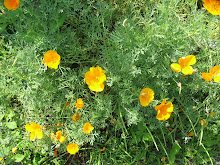Yesterday I could have continued putting my garden to bed; I've removed all of the dead annuals and started turning over the soil in preparation for planting a red clover ground cover. But I was drawn to another opportunity that the Boston Natural Areas Network (owner and promoter of our community garden) had to offer: a guided tour of the Stony Brook Reservation, the largest open space in the city of Boston. Located in the neighborhoods of West Roxbury and Hyde Park, it is also one of the city's least known and underutilized treasures.
The tour was led by Doug Mink, a member of the BNAN board who is also involved with the recently established Friends of Stony Brook, with help from Dave Furey, a ranger with the Department of Conservation and Recreation (DCR), a Massachusetts state agency. As we entered through a trailhead off of Enneking Parkway, they pointed out a rare sight: the Stony Brook, flowing in full view. This is the same body of water that once coursed above ground through Jamaica Plain, but had to be diverted into underground sewers in the 1930s because of unhealthy living conditions caused by flooding and pollution. The Stony Brook Conduit runs under the Minton Stable Garden property and is the reason our part of Jamaica Plain is called "Stoneybrook."
One of the reasons that the Stony Brook Reservation was developed as a green space is that it sits on granite and puddingstone, so the land could not be farmed. The plants that do thrive include red and black oaks and white pine; the approximately 20 tour participants had to use caution on the walking trails and paved bike paths to avoid slipping on fallen wet leaves and needles. Unfortunately, previous fires have wiped out the blueberries. We did not cover all 12 miles of available trails, but we were exposed to the highlights, including Turtle Pond and Bold Knob, the latter offering a view of the Blue Hills.
Though I've driven through the Reservation on the Turtle Pond and Enneking Parkways for at least ten years, I've only walked or biked the trails a handful of times because of safety concerns. But to our guides' knowledge, there have been no assaults in recent history. Most incidents have involved illegal or accidental fires and drowning in the Turtle Pond, which is surprisingly deep for its size and has a craggy shoreline. And the park's reputation for being a popular spot for activities that are, shall we say, not of a family nature has resulted in the closing of most of the parking lots. But some of us on the tour seemed to agree that locking the gates has been a counter-productive measure, leaving the park more deserted and less inviting.
I hope to bring friends to the Reservation soon; to explore the other sections either on foot, or when the time comes, on cross-country skis.
Subscribe to:
Post Comments (Atom)


2 comments:
Sounds great. Hope to be one of the friends who gets taken to Stony Brook.
As energy prices move higher and higher these green spaces inside cities will become much more popular.
Post a Comment